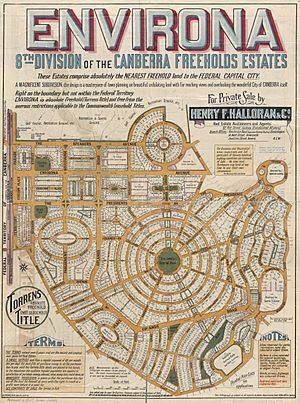Environa, New South Wales facts for kids
Quick facts for kids EnvironaQueanbeyan, New South Wales |
|||||||||||||||
|---|---|---|---|---|---|---|---|---|---|---|---|---|---|---|---|
| Population | 0 (2016) | ||||||||||||||
| Established | 1924 | ||||||||||||||
| Postcode(s) | 2620 | ||||||||||||||
| LGA(s) | Queanbeyan–Palerang | ||||||||||||||
| State electorate(s) | Monaro | ||||||||||||||
| Federal Division(s) | Eden-Monaro | ||||||||||||||
|
|||||||||||||||
Environa is a suburb and area near Queanbeyan in New South Wales, Australia. It is part of the Queanbeyan–Palerang Regional Council. Environa is located west of Jerrabomberra Creek, close to the border between New South Wales and the Australian Capital Territory.
This area was once planned to be a new community, but the plans never fully happened. Today, Environa is part of a larger development project called South Jerrabomberra. This project includes new plans for areas like Tralee and Poplars.
Contents
History of Environa
The land where Environa is located was originally part of a large grazing farm called Hill Station. It sits just east of the railway line that runs from Queanbeyan to Cooma. This area is also near the industrial part of Hume, ACT.
Early Plans for a New City
In 1924, a clever developer named Henry Ferdinand Halloran bought the land at an auction. He had big plans to create a new city there. Halloran believed the area had great potential because it was the closest privately owned land to the new federal territory.
Halloran's plans for the northern part of the area, called Canberra Freehold Estate, were very ambitious. They included spaces for offices, shops, a hospital, and even theatres. Some of the proposed street names were quite fancy, like Rue de Paris, Piazza di Roma, and Tokio Dori.
Monuments and Structures
Halloran also built several stone monuments in the southern part of the estate. These included a grand arch at the entrance and rows of stone pillars along the main road. He even put up a statue of Henry Parkes on a tall column.
A bandstand was also built, which had a roof made of corrugated iron supported by tree trunks. Another interesting structure was the main top-mast from the ship HMAS Sydney. However, this mast eventually rotted and fell down. It was later moved to Jervis Bay.
Why the Plans Failed
Unfortunately, no land blocks were sold, and the planned city never came to be. The Great Depression, a time of severe economic hardship, stopped the project. Because of unpaid taxes, the Queanbeyan Council took back the land to the north. This area later became part of South Queanbeyan.
Henry Halloran passed away in 1953. His daughter, Joyce Larcombe, inherited the Environa property. A house was built there in 1971. Halloran's company, Reality Realizations, still owned a lot of land around Queanbeyan into the 1970s.
The Letchworth Railway Station
Between 1926 and 1956, there was a railway station just north of Environa. It was on the Bombala railway line and was named Letchworth. Halloran suggested this name, inspired by Letchworth Garden City in England. The station was closer to another of Halloran's undeveloped projects, also called Letchworth. However, it would have served Environa if that development had gone ahead.
Modern Changes to Environa
For a long time, the original planned street layout of Environa, even though it was never built, could be seen on Google Maps and Apple Maps. You could still see it in early 2021 if you zoomed in closely.
However, this is now changing. Major development work has started as part of the South Jerrabomberra project, especially in Tralee, which is just southeast of Environa. A new main road, Environa Drive, is being built to connect the new area to Tompsitt Drive. One reason the area remained undeveloped for so long was concern about aircraft noise if Canberra Airport expanded.
Geography of Environa
Environa is located on the lower slopes of Pemberton Hill, which is to the south. The area is about 620 to 660 meters (2,030 to 2,165 feet) above sea level. The rocks in Environa are made of volcanic material, specifically rhyodacite and rhyolite. These rocks are part of the Deakin Volcanics and formed about 414 million years ago.



